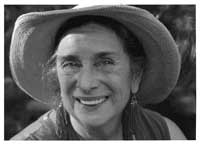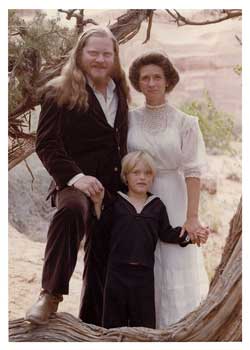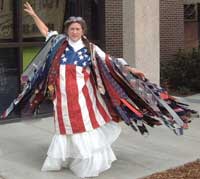 When I asked Eleanor why Moab, she looked at me like it should be obvious and said, “Because I wanted to be in the desert.” Thirty-six years ago she, Dennis Spikerman (Spike), and their four-year-old son Orion moved from Salt Lake City where Eleanor had graduated from the University of Utah with a degree in economics. “I had a lot of extra credits. I was quite eclectic in my interests.” Eclectic is, in fact, an excellent one word descriptor of Eleanor Inskip.
When I asked Eleanor why Moab, she looked at me like it should be obvious and said, “Because I wanted to be in the desert.” Thirty-six years ago she, Dennis Spikerman (Spike), and their four-year-old son Orion moved from Salt Lake City where Eleanor had graduated from the University of Utah with a degree in economics. “I had a lot of extra credits. I was quite eclectic in my interests.” Eclectic is, in fact, an excellent one word descriptor of Eleanor Inskip.
Between graduation and moving to Moab, Eleanor spent three months in Europe. She returned to Salt Lake City where there were few jobs, so she joined VISTA, the domestic Peace Corps. She was sent to train on the Ogallala Indian Reservation with eighteen Sioux and one other anglo volunteer. “I had never seen such poverty as I saw there, and I was an Air Force brat--had been in post war Japan and China. It was a whole nation of severely depressed people. “I knew things were much better on the Navajo Reservation, that they had made the system work for themselves. So the eighteen of us took two VISTA Suburbans and drove to northeast Arizona to spend the weekend on the Reservation. The difference between the two reservations was staggering; those young Ogallala Sioux saw it, and I like to think it made a difference.” That was a typical Eleanor response to a problem--creative and direct.
 Eleanor was laid off from VISTA when they found out she was pregnant. Back in Salt Lake, Eleanor birthed Orion, put together a food co-op, baked bread for Momma Eddie’s Right-on Beanery, was the business manager/bookkeeper for Marmalade School, and a nanny.
Eleanor was laid off from VISTA when they found out she was pregnant. Back in Salt Lake, Eleanor birthed Orion, put together a food co-op, baked bread for Momma Eddie’s Right-on Beanery, was the business manager/bookkeeper for Marmalade School, and a nanny.
Then it was 1976--time for the desert. Eleanor was hired for 20 hours a week by Canyonlands Natural History Association (CNHA). She was the first non park service employee. She also worked at the Poplar Place, which Spike had purchased, making the best pizza in town and waiting tables as needed. After a particularly nasty run-in with an underage drinker and her defender, Eleanor quit working at the bar.
Although Eleanor wasn’t exactly kicking around looking for something to do with a four-year-old and steadily increasing hours at CNHA, she enjoyed and helped create much of Moab’s home-grown culture. She was the catcher for Real People Press softball team, the costumer for Moab Community Theater, and a founding board member of Canyonlands Field Institute. A member of the Chamber of Commerce, she was soon involved in a group called Moab Area Promotion for which she wrote the articles of incorporation. This group was the point organization promoting tourism in Moab. A number of agencies and government entities cooperated to published a slick, photo oriented booklet called The Magic of Moab the popularity of which demanded several printings. Eleanor was the production designer and editor.
Eleanor, now executive director of the growing CNHA, was invited to become a Rotarian. Rotary International was still banning women from membership. “When I made my first presentation to the Rotarians, I looked out and realized I was the only woman there. It took me back to college and being the only woman in most economics classes. Two Rotarians I especially respected were Don Knowles and Ed Klaus. They wanted to see this community heal.” The wound of poor economic times as a result of falling uranium prices drove a wedge between those citizens who saw salvation in attracting tourists and those hoping for an infusion of federal money for a high-level nuclear waste repository in Lavendar Canyon. There were, of course, other ideas, but those were the most viable in the mid-eighties.
 When Eleanor heard that the Department of Energy (DOE) was considering the creation of a “religion” to warn people away from the high level nuclear repository for the 10,000 years it would be toxic, she knew her skills were needed to design the outfits for those Atomic Priests [the DOE’s own name for them]. Thus, began her Atomic Priesthood Regalia which has grown from The All American Woman (her initial outfit) to eleven completed designs currently on display at Museum of Moab.
When Eleanor heard that the Department of Energy (DOE) was considering the creation of a “religion” to warn people away from the high level nuclear repository for the 10,000 years it would be toxic, she knew her skills were needed to design the outfits for those Atomic Priests [the DOE’s own name for them]. Thus, began her Atomic Priesthood Regalia which has grown from The All American Woman (her initial outfit) to eleven completed designs currently on display at Museum of Moab.
Adrien Taylor, Publisher Emeritus of the Times-Independent, observed, “Eleanor Inskip has been here in Moab during at least one of its ups and downs. During the especially trying years of the early 1980’s she joined hands and efforts with other community minded citizens in the planning and building of the Moab Information Center on the southwest corner of Main and Center Streets.” It was a unique undertaking for a natural history association--serving the Bureau of Land Management and Forest Service as well as the National Park Service. Completed, it became not only an example of professional interpretive services, but also, the template for other multi-agency associations around the country.
After Eleanor left CNHA, she researched, wrote, and published The Colorado River Through Glen Canyon: Before Lake Powell, a powerful reminder of what was lost when the canyon was flooded. Then she moved to Washington, D.C. where she further immersed herself in research, largely on John Wesley Powell, and the USGS topographical map collection. She worked as a temp for National Geographic Magazine.
After returning to Moab in 2003 Eleanor served a term as the director/curator of the Museum of Moab, owned and operated a bed and breakfast, and, as Adrien Taylor observed with a mischievous chuckle, “Currently, she is also raising exotic chickens.”
Pragmatist and idealist, administrator and artist, Eleanor Inskip is still helping us weave the fabric of community in Moab.
 When I asked Eleanor why Moab, she looked at me like it should be obvious and said, “Because I wanted to be in the desert.” Thirty-six years ago she, Dennis Spikerman (Spike), and their four-year-old son Orion moved from Salt Lake City where Eleanor had graduated from the University of Utah with a degree in economics. “I had a lot of extra credits. I was quite eclectic in my interests.” Eclectic is, in fact, an excellent one word descriptor of Eleanor Inskip.
When I asked Eleanor why Moab, she looked at me like it should be obvious and said, “Because I wanted to be in the desert.” Thirty-six years ago she, Dennis Spikerman (Spike), and their four-year-old son Orion moved from Salt Lake City where Eleanor had graduated from the University of Utah with a degree in economics. “I had a lot of extra credits. I was quite eclectic in my interests.” Eclectic is, in fact, an excellent one word descriptor of Eleanor Inskip. Eleanor was laid off from VISTA when they found out she was pregnant. Back in Salt Lake, Eleanor birthed Orion, put together a food co-op, baked bread for Momma Eddie’s Right-on Beanery, was the business manager/bookkeeper for Marmalade School, and a nanny.
Eleanor was laid off from VISTA when they found out she was pregnant. Back in Salt Lake, Eleanor birthed Orion, put together a food co-op, baked bread for Momma Eddie’s Right-on Beanery, was the business manager/bookkeeper for Marmalade School, and a nanny. When Eleanor heard that the Department of Energy (DOE) was considering the creation of a “religion” to warn people away from the high level nuclear repository for the 10,000 years it would be toxic, she knew her skills were needed to design the outfits for those Atomic Priests [the DOE’s own name for them]. Thus, began her Atomic Priesthood Regalia which has grown from The All American Woman (her initial outfit) to eleven completed designs currently on display at Museum of Moab.
When Eleanor heard that the Department of Energy (DOE) was considering the creation of a “religion” to warn people away from the high level nuclear repository for the 10,000 years it would be toxic, she knew her skills were needed to design the outfits for those Atomic Priests [the DOE’s own name for them]. Thus, began her Atomic Priesthood Regalia which has grown from The All American Woman (her initial outfit) to eleven completed designs currently on display at Museum of Moab.